Duplicated zebrafish co-orthologs of parathyroid hormone-related peptide (PTHrP, Pthlh) play different roles in craniofacial skeletogenesis
- PMID: 22761277
- PMCID: PMC3718479
- DOI: 10.1530/JOE-12-0110
Duplicated zebrafish co-orthologs of parathyroid hormone-related peptide (PTHrP, Pthlh) play different roles in craniofacial skeletogenesis
Abstract
In mammals, parathyroid hormone-related peptide (PTHrP, alias PTH-like hormone (Pthlh)) acts as a paracrine hormone that regulates the patterning of cartilage, bone, teeth, pancreas, and thymus. Beyond mammals, however, little is known about the molecular genetic mechanisms by which Pthlh regulates early development. To evaluate conserved pathways of craniofacial skeletogenesis, we isolated two Pthlh co-orthologs from the zebrafish (Danio rerio) and investigated their structural, phylogenetic, and syntenic relationships, expression, and function. Results showed that pthlh duplicates originated in the teleost genome duplication. Zebrafish pthlha and pthlhb were maternally expressed and showed overlapping and distinct zygotic expression patterns during skeletal development that mirrored mammalian expression domains. To explore the regulation of duplicated pthlh genes, we studied their expression patterns in mutants and found that both sox9a and sox9b are upstream of pthlha in arch and fin bud cartilages, but only sox9b is upstream of pthlha in the pancreas. Morpholino antisense knockdown showed that pthlha regulates both sox9a and sox9b in the pharyngeal arches but not in the brain or otic vesicles and that pthlhb does not regulate either sox9 gene, which is likely related to its highly degraded nuclear localization signal. Knockdown of pthlha but not pthlhb caused runx2b overexpression in craniofacial cartilages and premature bone mineralization. We conclude that in normal cartilage development, sox9 upregulates pthlh, which downregulates runx2, and that the duplicated nature of all three of these genes in zebrafish creates a network of regulation by different co-orthologs in different tissues.
Conflict of interest statement
The authors declare that there is no conflict of interest that could be perceived as prejudicing the impartiality of the research reported.
Figures
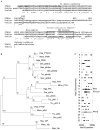

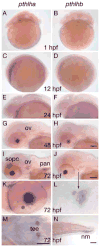
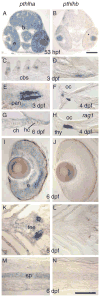

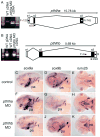
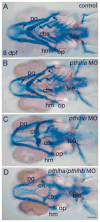
Similar articles
-
A zebrafish sox9 gene required for cartilage morphogenesis.Development. 2002 Nov;129(21):5065-79. doi: 10.1242/dev.129.21.5065. Development. 2002. PMID: 12397114
-
A pair of Sox: distinct and overlapping functions of zebrafish sox9 co-orthologs in craniofacial and pectoral fin development.Development. 2005 Mar;132(5):1069-83. doi: 10.1242/dev.01674. Epub 2005 Feb 2. Development. 2005. PMID: 15689370
-
Two sox9 genes on duplicated zebrafish chromosomes: expression of similar transcription activators in distinct sites.Dev Biol. 2001 Mar 1;231(1):149-63. doi: 10.1006/dbio.2000.0129. Dev Biol. 2001. PMID: 11180959
-
Molecular dissection of craniofacial development using zebrafish.Crit Rev Oral Biol Med. 2002;13(4):308-22. doi: 10.1177/154411130201300402. Crit Rev Oral Biol Med. 2002. PMID: 12191958 Review.
-
Zebrafish: A Suitable Tool for the Study of Cell Signaling in Bone.Cells. 2020 Aug 17;9(8):1911. doi: 10.3390/cells9081911. Cells. 2020. PMID: 32824602 Free PMC article. Review.
Cited by
-
Stress, Glucocorticoids and Bone: A Review From Mammals and Fish.Front Endocrinol (Lausanne). 2018 Sep 10;9:526. doi: 10.3389/fendo.2018.00526. eCollection 2018. Front Endocrinol (Lausanne). 2018. PMID: 30250453 Free PMC article. Review.
-
Probiotics Enhance Bone Growth and Rescue BMP Inhibition: New Transgenic Zebrafish Lines to Study Bone Health.Int J Mol Sci. 2022 Apr 26;23(9):4748. doi: 10.3390/ijms23094748. Int J Mol Sci. 2022. PMID: 35563140 Free PMC article.
-
Pthlha and mechanical force control early patterning of growth zones in the zebrafish craniofacial skeleton.Development. 2022 Jan 15;149(2):dev199826. doi: 10.1242/dev.199826. Epub 2022 Jan 20. Development. 2022. PMID: 34919126 Free PMC article.
-
Targeted Pth4-expressing cell ablation impairs skeletal mineralization in zebrafish.PLoS One. 2017 Oct 17;12(10):e0186444. doi: 10.1371/journal.pone.0186444. eCollection 2017. PLoS One. 2017. PMID: 29040309 Free PMC article.
-
Connecting Bone Remodeling and Regeneration: Unraveling Hormones and Signaling Pathways.Biology (Basel). 2025 Mar 7;14(3):274. doi: 10.3390/biology14030274. Biology (Basel). 2025. PMID: 40136530 Free PMC article. Review.
References
Publication types
MeSH terms
Substances
Grants and funding
LinkOut - more resources
Full Text Sources
Molecular Biology Databases
Research Materials

